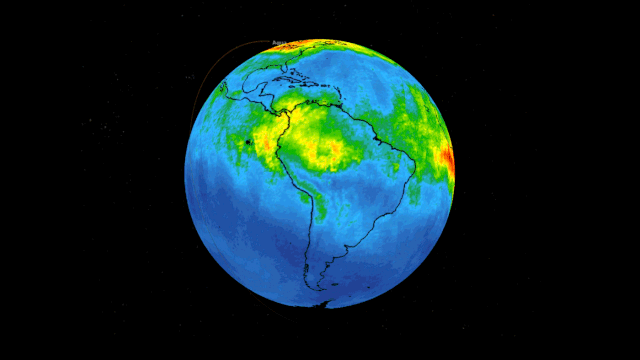Watch a Noxious Cloud of Carbon Monoxide Pollution Spill Out of the Burning Amazon
The Amazon is burning, and it's leaking a huge plume of carbon monoxide into the atmosphere. Hopefully, the cloud will disappear within a month.

The Amazon rainforest is burning, thanks to hundreds of wildfires set by people. Now, NASA has detected a gargantuan cloud of noxious carbon monoxide (CO) rising from the blaze into the atmosphere.
In frightening new imagery on NASA's website, you can watch the cloud evolve between Aug. 8 and 22. The pictures come from a satellite-mounted instrument called the Atmospheric Infrared Sounder (AIRS), which detects infrared radiation in Earth's atmosphere.
The plume first appears as a greenish blob over Brazil before rapidly spreading out past the eastern and western coasts of South America, gradually darkening from green to yellow to red. This color shift signifies an increase in CO concentration in the atmosphere from about 100 parts per billion by volume (ppbv) to 160 ppbv in less than two weeks. (According to the University Corporation for Atmospheric Research, 100 ppbv is normal for the lower atmosphere — 160 is not).
Related: Photos Show Horrifying California Wildfires
"A pollutant that can travel large distances, carbon monoxide can persist in the atmosphere for about a month," NASA wrote in a press release. "At the high altitude mapped in these images [about 18,000 feet, or 5,500 meters above the forest], the gas has little effect on the air we breathe; however, strong winds can carry it downward to where it can significantly impact air quality."
CO is odorless, colorless and tasteless, making it an especially dangerous pollutant. According to the Mayo Clinic, after overexposure to CO fumes, your body may replace oxygen in your red blood cells with CO, preventing oxygen from reaching your bloodstream and leading to brain damage and even death. Volcanoes and brush fires regularly belch trace amounts of CO into the atmosphere. But human activity, mainly in the form of car exhaust and emissions from industrial processes, contributes to huge spikes in CO concentration over cities.
While the recently spotted cloud may float at too high an altitude to pose a serious risk on the ground, it's not the only airborne hazard released by the ongoing wildfires. Last week, smoke from the fires traveled halfway across Brazil to blanket São Paulo in a midnight-black haze in the middle of the afternoon.
Get the world’s most fascinating discoveries delivered straight to your inbox.
Most of the Amazon fires were likely set intentionally to deforest parts of the rainforest for industrial use, Live Science previously reported. Brazilian President Jair Bolsonaro, who rejects mainstream climate science, has promised to open the Amazon to industry.
Indeed, deforestation in the Amazon spiked 278% in July 2019 compared to July 2018, according to satellite data from the Brazilian government's National Institute for Space Research (INPE). Bolsonaro disputed the satellite findings and promptly fired the INPE's director-general, Ricardo Galvão, after the data release.
- 6 Unexpected Effects of Climate Change
- The Reality of Climate Change: 10 Myths Busted
- Top 10 Ways to Destroy Earth
Originally published on Live Science.

Brandon is the space / physics editor at Live Science. With more than 20 years of editorial experience, his writing has appeared in The Washington Post, Reader's Digest, CBS.com, the Richard Dawkins Foundation website and other outlets. He holds a bachelor's degree in creative writing from the University of Arizona, with minors in journalism and media arts. His interests include black holes, asteroids and comets, and the search for extraterrestrial life.


